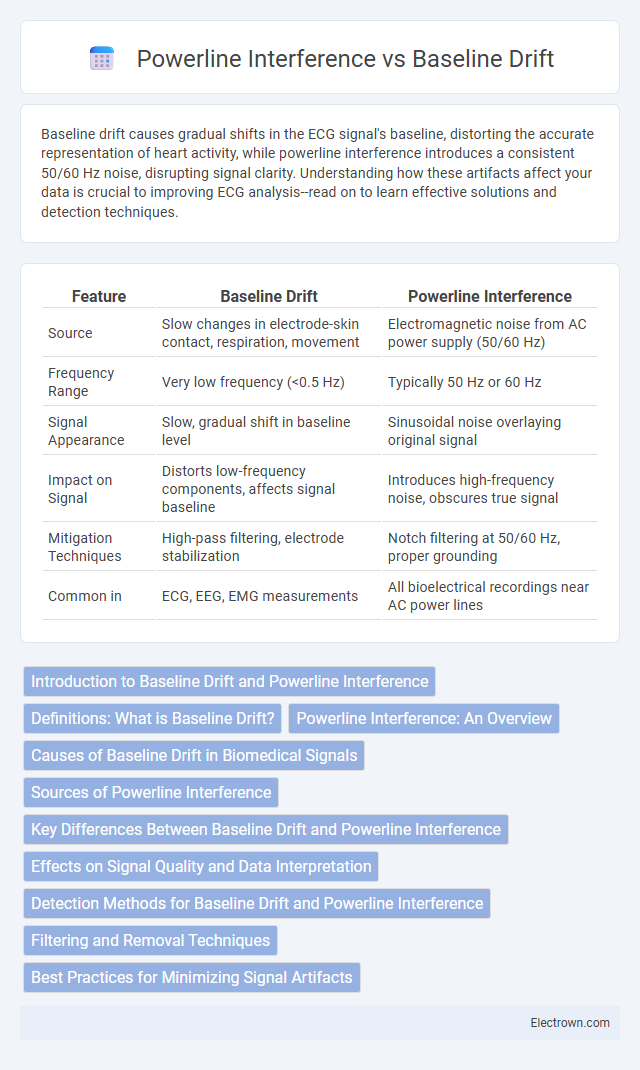Baseline drift causes gradual shifts in the ECG signal's baseline, distorting the accurate representation of heart activity, while powerline interference introduces a consistent 50/60 Hz noise, disrupting signal clarity. Understanding how these artifacts affect your data is crucial to improving ECG analysis--read on to learn effective solutions and detection techniques.
Table of Comparison
| Feature | Baseline Drift | Powerline Interference |
|---|---|---|
| Source | Slow changes in electrode-skin contact, respiration, movement | Electromagnetic noise from AC power supply (50/60 Hz) |
| Frequency Range | Very low frequency (<0.5 Hz) | Typically 50 Hz or 60 Hz |
| Signal Appearance | Slow, gradual shift in baseline level | Sinusoidal noise overlaying original signal |
| Impact on Signal | Distorts low-frequency components, affects signal baseline | Introduces high-frequency noise, obscures true signal |
| Mitigation Techniques | High-pass filtering, electrode stabilization | Notch filtering at 50/60 Hz, proper grounding |
| Common in | ECG, EEG, EMG measurements | All bioelectrical recordings near AC power lines |
Introduction to Baseline Drift and Powerline Interference
Baseline drift refers to the slow, gradual fluctuations in the baseline signal level of physiological recordings, often caused by patient movement, electrode impedance changes, or breathing patterns. Powerline interference is the electromagnetic noise originating from electrical power sources, typically at 50 or 60 Hz, which contaminates signals such as ECG or EEG recordings. Both artifacts significantly impact signal quality, necessitating specialized filtering techniques for accurate biomedical signal analysis.
Definitions: What is Baseline Drift?
Baseline drift refers to the slow, low-frequency fluctuations in the baseline level of a signal, commonly observed in physiological recordings such as ECG or EEG. It can obscure vital information by causing gradual shifts in the signal baseline, making accurate analysis challenging. You can minimize baseline drift through proper sensor placement and signal processing techniques.
Powerline Interference: An Overview
Powerline interference is a common source of noise in biomedical signal acquisition, caused by electromagnetic fields from nearby electrical power sources operating at 50 or 60 Hz. This interference manifests as periodic fluctuations in the recorded signal, often distorting critical diagnostic information. To minimize its impact, your equipment may utilize specialized filters or shielding techniques designed to reduce powerline artifact while preserving the integrity of the underlying physiological signals.
Causes of Baseline Drift in Biomedical Signals
Baseline drift in biomedical signals primarily results from patient movement, electrode impedance changes, and respiration artifacts, causing slow, low-frequency variations in the signal baseline. Powerline interference, in contrast, originates from electromagnetic radiation of 50/60 Hz from surrounding electrical devices and wiring, manifesting as a high-frequency noise superimposed on the signal. Effective signal processing techniques must distinguish between these low-frequency baseline drifts and high-frequency powerline interference to enhance diagnostic accuracy.
Sources of Powerline Interference
Powerline interference originates primarily from the electromagnetic fields generated by alternating current (AC) power lines operating at 50 or 60 Hz, which induce unwanted noise in sensitive electronic equipment. Common sources include fluorescent lighting, electric motors, and household appliances that create harmonic distortions and transient spikes. Shielding, proper grounding, and filtering techniques are essential to mitigate these disturbances and maintain signal integrity in biomedical and communication systems.
Key Differences Between Baseline Drift and Powerline Interference
Baseline drift is a slow, gradual change in the electrocardiogram (ECG) baseline caused by factors such as patient movement, respiration, or electrode issues, resulting in low-frequency artifacts. Powerline interference appears as a high-frequency, constant sinusoidal noise at 50 or 60 Hz due to electromagnetic disturbance from electrical power sources. Key differences include the frequency spectrum (low-frequency drift versus high-frequency noise), origin (physiological/artifact vs. electrical interference), and impact on signal clarity, where baseline drift affects overall waveform stability and powerline interference introduces repetitive noise patterns.
Effects on Signal Quality and Data Interpretation
Baseline drift causes slow fluctuations in the ECG signal, leading to inaccurate measurement of waveform amplitudes and intervals, which compromises diagnostic accuracy. Powerline interference introduces a consistent 50/60 Hz noise that distorts the signal's fine details, often masking important features like the QRS complex or P waves. Both artifacts degrade signal quality, but baseline drift impacts long-term trend analysis while powerline interference primarily affects instantaneous event detection and interpretation.
Detection Methods for Baseline Drift and Powerline Interference
Detection methods for baseline drift primarily involve high-pass filtering techniques and empirical mode decomposition to isolate slow-varying trends in ECG or EEG signals. Powerline interference is typically identified using notch filters tuned to specific frequencies such as 50 Hz or 60 Hz, or through adaptive filtering algorithms that extract periodic noise components. Your signal processing workflow benefits from combining these detection strategies to effectively separate baseline drift and powerline interference for accurate biomedical signal analysis.
Filtering and Removal Techniques
Baseline drift is typically addressed using high-pass filters or detrending algorithms that remove low-frequency fluctuations without affecting the core signal, while powerline interference is effectively suppressed by narrow-band notch filters centered at 50 or 60 Hz. Adaptive filtering techniques and wavelet transforms also enhance removal accuracy by targeting the distinct frequency components of each artifact. Your signal processing strategy should select filtering methods based on the specific noise characteristics to ensure minimal signal distortion.
Best Practices for Minimizing Signal Artifacts
To minimize baseline drift in your signal recordings, ensure electrode-skin impedance is low by cleaning skin and securing electrodes firmly, while maintaining a stable temperature environment to prevent slow signal shifts. Powerline interference can be reduced using proper shielding, grounding techniques, and notch filters centered at 50/60 Hz, preserving signal integrity. Combining careful hardware setup with signal processing methods like adaptive filtering offers the best practice for reducing both baseline drift and powerline artifacts in biomedical signals.
Baseline Drift vs Powerline Interference Infographic

 electrown.com
electrown.com